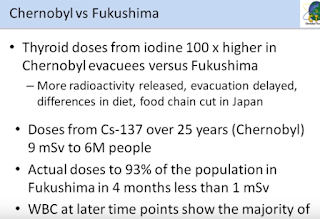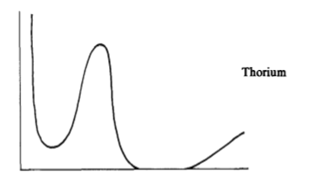On Half-Life and radiation
As I am an engineer by training and trade, I feel an important perspective can be gained by listening to a toxicologist. Therefore I am adding the following YouTube video, it's an 80 minute lecture given at the University of South Australia by Professor Geraldine "Gerry" Thomas.
Any discussion of nuclear energy or nuclear technology, of any sort, probably should begin by explaining the concept of 'half-life'. Although this is probably well understood by many readers it is a concept that recurs so frequently that I feel if I don't explain this I am doing my readers a disservice.
Wikipedia at the time of writing this defines half life as follows:
Half-Life (symbol t1⁄2) is the time required for a quantity to reduce to half of its initial value. The term is commonly used in nuclear physics to describe how quickly unstable atoms undergo, or how long stable atoms survive, radioactive decay.
I guess if you read that a few times it kind of, sort of, makes sense. How about a really simple explanation.
Nuclear Half-life is a measure of how unstable the nucleus of a particular atom is. A very stable atomic nucleus will have a very long half-life, whereas an unstable nucleus might have a very short half-life.
Now lets talk practical terms, most atoms in our everyday world are stable stuff, they do not undergo radio-decay (thus in a sense their half-life is infinitely long). But there are lots of unstable atoms in our everyday life as well. For example smoke detectors have Americium-241. (For the curious, an easy to read explanation of the inner workings of a smoke detector can be found here.)
Lets have a look at Americium-241, Am-241 has 95 protons and 146 neutrons, notice if we sum 95 + 146 we get 241 - not an accident!
Aside: The type of element, hydrogen, helium, uranium, is determined by the number of protons. Hydrogen has one proton, helium as two protons, and so forth. But the number of neutrons can change with only the very slightest impact on the weight of an element. For example, add a neutron to a lonely proton and instead of hydrogen you have deuterium, exactly the same thing, just a little heavier. This concept of same type, different weight atom is an isotope, deuterium is an isotope of hydrogen, tritium (Hydrogen-3) is another isotope.
Now, back to Am-241, it has an unstable atomic nucleus, if you left a single atom of Am-241 to sit on a shelf for 432.2 years there is a one in two chance that the Am-241 will shed a helium nucleus (called an alpha particle), the physicists would write out what is going on like this:
What does that all mean? Well read from left to right, we start with element 95, weight 241 (Americium), we wait, on average 432.2 years and we find ourselves with element 93, weight 237 (Neptunium) and an element 2 weight 4 (Helium) with a 2+ (positive electric charge, it's missing it's two electrons) and a gamma ray burst at 59.5409 keV (a measure of the energy of the gamma ray, gamma rays are just a super energetic form of light, much like radio waves, microwaves, x-rays, gamma rays just pack more energy.)
That's actually interesting, because if you take that 237-Np and bombard it with neutrons you get some Np-238. Well Np-238 is actually really handy because it quickly undergoes beta decay and becomes something very useful to NASA.
But what is beta decay?
Beta decay is when a neutron at the nucleus of an atom kicks off a proton and an electron. The proton sticks around, but the electron has so much energy it zooms off into space. That electron is called a beta particle. As for the nucleus that just endured the beta decay, the total number of protons and neutrons is unchanged, one fewer neutrons, but one more protons, so it's a different element, at the same atomic mass.
If we recall we started with Am-241, after waiting a long time (more than 432 years) half the Americium would have shed an alpha particle, if we then separate the Neptunium from the remaining Americium and expose the neptunium to neutrons we will get Np-238. Well leave the Np-238 alone for a short time (it's half-life is just over 2 days) and...
Element 94. The story goes when they went to come up with the chemical symbol for 94 the man who first isolated it, Glenn Seaborg decided to use the American idiom for awful or gross, P-u. He named the element after the recently discovered planet, Pluto, Seaborg won a share of the 1951 Nobel prize in chemistry in part for his discovery of Plutonium.
So we can build a bomb from smoke detectors? No! Pu238 wouldn't work in a bomb, but it is very useful if you make it into a salt and shove it inside a small container. The Plutonium will undergo alpha decay with a half life of 87.7 years, this alpha decay will release heat, not much but enough to power a few cameras or other small sensors and maybe a modest communications system.
Meet Voyager, two were launched just a couple months before I was born, they are out, literally billions of miles from the nearest gas station, but the Radio isotope Thermal electric Generator (RTG) continue to provide enough power to keep a few systems running more than 40 years later. The steady alpha decay of Pu-238 inside voyager has given us a brilliant understanding of our solar system and some of the most stunning photographs of our naturalworld... universe.
There's a lot more I want to discuss but I'm sure we all need a break, in the meantime here are some images I found courtesy of NASA and a tiny little machine farther from Earth than any other object humans have ever built.


Any discussion of nuclear energy or nuclear technology, of any sort, probably should begin by explaining the concept of 'half-life'. Although this is probably well understood by many readers it is a concept that recurs so frequently that I feel if I don't explain this I am doing my readers a disservice.
Wikipedia at the time of writing this defines half life as follows:
Half-Life (symbol t1⁄2) is the time required for a quantity to reduce to half of its initial value. The term is commonly used in nuclear physics to describe how quickly unstable atoms undergo, or how long stable atoms survive, radioactive decay.
I guess if you read that a few times it kind of, sort of, makes sense. How about a really simple explanation.
Nuclear Half-life is a measure of how unstable the nucleus of a particular atom is. A very stable atomic nucleus will have a very long half-life, whereas an unstable nucleus might have a very short half-life.
Now lets talk practical terms, most atoms in our everyday world are stable stuff, they do not undergo radio-decay (thus in a sense their half-life is infinitely long). But there are lots of unstable atoms in our everyday life as well. For example smoke detectors have Americium-241. (For the curious, an easy to read explanation of the inner workings of a smoke detector can be found here.)
Lets have a look at Americium-241, Am-241 has 95 protons and 146 neutrons, notice if we sum 95 + 146 we get 241 - not an accident!
Aside: The type of element, hydrogen, helium, uranium, is determined by the number of protons. Hydrogen has one proton, helium as two protons, and so forth. But the number of neutrons can change with only the very slightest impact on the weight of an element. For example, add a neutron to a lonely proton and instead of hydrogen you have deuterium, exactly the same thing, just a little heavier. This concept of same type, different weight atom is an isotope, deuterium is an isotope of hydrogen, tritium (Hydrogen-3) is another isotope.
Now, back to Am-241, it has an unstable atomic nucleus, if you left a single atom of Am-241 to sit on a shelf for 432.2 years there is a one in two chance that the Am-241 will shed a helium nucleus (called an alpha particle), the physicists would write out what is going on like this:
What does that all mean? Well read from left to right, we start with element 95, weight 241 (Americium), we wait, on average 432.2 years and we find ourselves with element 93, weight 237 (Neptunium) and an element 2 weight 4 (Helium) with a 2+ (positive electric charge, it's missing it's two electrons) and a gamma ray burst at 59.5409 keV (a measure of the energy of the gamma ray, gamma rays are just a super energetic form of light, much like radio waves, microwaves, x-rays, gamma rays just pack more energy.)
That's actually interesting, because if you take that 237-Np and bombard it with neutrons you get some Np-238. Well Np-238 is actually really handy because it quickly undergoes beta decay and becomes something very useful to NASA.
But what is beta decay?
Beta decay is when a neutron at the nucleus of an atom kicks off a proton and an electron. The proton sticks around, but the electron has so much energy it zooms off into space. That electron is called a beta particle. As for the nucleus that just endured the beta decay, the total number of protons and neutrons is unchanged, one fewer neutrons, but one more protons, so it's a different element, at the same atomic mass.
If we recall we started with Am-241, after waiting a long time (more than 432 years) half the Americium would have shed an alpha particle, if we then separate the Neptunium from the remaining Americium and expose the neptunium to neutrons we will get Np-238. Well leave the Np-238 alone for a short time (it's half-life is just over 2 days) and...
Element 94. The story goes when they went to come up with the chemical symbol for 94 the man who first isolated it, Glenn Seaborg decided to use the American idiom for awful or gross, P-u. He named the element after the recently discovered planet, Pluto, Seaborg won a share of the 1951 Nobel prize in chemistry in part for his discovery of Plutonium.
So we can build a bomb from smoke detectors? No! Pu238 wouldn't work in a bomb, but it is very useful if you make it into a salt and shove it inside a small container. The Plutonium will undergo alpha decay with a half life of 87.7 years, this alpha decay will release heat, not much but enough to power a few cameras or other small sensors and maybe a modest communications system.
Meet Voyager, two were launched just a couple months before I was born, they are out, literally billions of miles from the nearest gas station, but the Radio isotope Thermal electric Generator (RTG) continue to provide enough power to keep a few systems running more than 40 years later. The steady alpha decay of Pu-238 inside voyager has given us a brilliant understanding of our solar system and some of the most stunning photographs of our natural
There's a lot more I want to discuss but I'm sure we all need a break, in the meantime here are some images I found courtesy of NASA and a tiny little machine farther from Earth than any other object humans have ever built.




![{\displaystyle {\ce {^{237}_{93}Np + ^{1}_{0}n -> ^{238}_{93}Np ->[\beta^-][2.117 \ {\ce {d}}] ^{238}_{94}Pu}}}](https://wikimedia.org/api/rest_v1/media/math/render/svg/18a4a99dfdd1831d6e5ba84881bc0c24d9985cc8)





Comments
Post a Comment